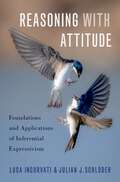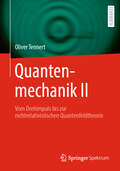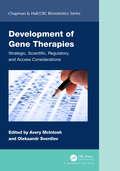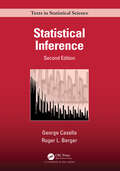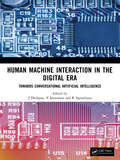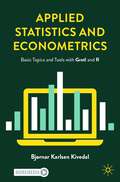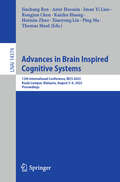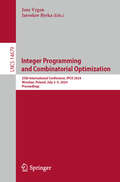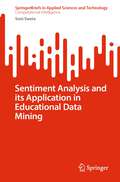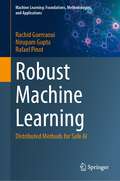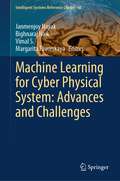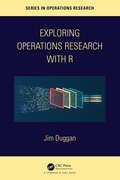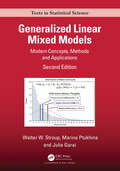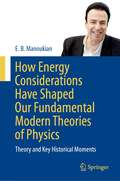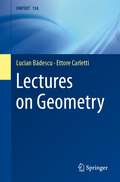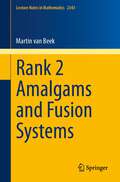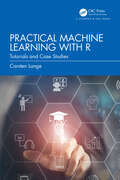- Table View
- List View
Reasoning with Attitude: Foundations and Applications of Inferential Expressivism
by Luca Incurvati Julian J. Schl?derThis is an open access title available under the terms of a CC BY-NC-ND 4.0 license. It is free to read at Oxford Academic and offered as a free PDF download from OUP and selected open access locations. Certain combinations of sounds or signs on paper are meaningful. What makes it the case that, unlike most combinations of sounds or signs, they have meaning? What is this meaning that they have? And what is it to understand this meaning? This book advances new answers to these questions by developing inferential expressivism, a novel approach to the study of meaning which combines elements of the expressivist and inferentialist programs. Expressivists explain the meaning of words in terms of the attitudes that words are used to express; inferentialists explain the meaning of words in terms of the inferences that words are used to draw. Reasoning with Attitude lays out the foundations of inferential expressivism by defending the view that the meaning of an expression is to be explained in terms of the inferences we draw involving the attitudes we express. As the book shows, by joining forces, expressivism and inferentialism can meet their key challenges whilst retaining their distinctive insights and advantages. Notably, inferential expressivism solves the Frege-Geach Problem plaguing expressivism, and addresses the charge that inferentialism has limited applicability. The book demonstrates the fruitfulness of the inferential expressivist approach by applying it to several open questions in semantics from different areas of inquiry, including epistemic operators and conditionals in the philosophy of language, negation and the truth predicate in the philosophy of logic, and normative vocabulary in meta-ethics.
Reasoning with Attitude: Foundations and Applications of Inferential Expressivism
by Luca Incurvati Julian J. Schl?derThis is an open access title available under the terms of a CC BY-NC-ND 4.0 license. It is free to read at Oxford Academic and offered as a free PDF download from OUP and selected open access locations. Certain combinations of sounds or signs on paper are meaningful. What makes it the case that, unlike most combinations of sounds or signs, they have meaning? What is this meaning that they have? And what is it to understand this meaning? This book advances new answers to these questions by developing inferential expressivism, a novel approach to the study of meaning which combines elements of the expressivist and inferentialist programs. Expressivists explain the meaning of words in terms of the attitudes that words are used to express; inferentialists explain the meaning of words in terms of the inferences that words are used to draw. Reasoning with Attitude lays out the foundations of inferential expressivism by defending the view that the meaning of an expression is to be explained in terms of the inferences we draw involving the attitudes we express. As the book shows, by joining forces, expressivism and inferentialism can meet their key challenges whilst retaining their distinctive insights and advantages. Notably, inferential expressivism solves the Frege-Geach Problem plaguing expressivism, and addresses the charge that inferentialism has limited applicability. The book demonstrates the fruitfulness of the inferential expressivist approach by applying it to several open questions in semantics from different areas of inquiry, including epistemic operators and conditionals in the philosophy of language, negation and the truth predicate in the philosophy of logic, and normative vocabulary in meta-ethics.
Quantenmechanik II: Vom Drehimpuls bis zur nichtrelativistischen Quantenfeldtheorie
by Oliver TennertIn einer umfassenden Darstellung entwickeln und vertiefen die vier Bände dieses Lehrbuchs das Gebäude der nichtrelativistischen Quantenmechanik, weshalb sie auch bestens als Nachschlagewerk geeignet sind. Der zweite Band behandelt den quantenmechanischen Drehimpuls, sowie Symmetrien in der nichtrelativistischen Quantenmechanik. Anschließend wird das wichtige Anwendungsgebiet der dreidimensionalen Probleme sowohl auf algebraischem Wege als auch mit analytischen Methoden untersucht. Es schließen sich Kapitel zu Teilchen in elektromagnetischen Feldern und zum großen Themenkomplex identischer Teilchen an, welcher nahtlos zur Feldquantisierung weiterführt. Besonderheiten: Auch komplizierte Zusammenhänge werden illustrativ und klar erklärt. Zahlreiche mathematische Einschübe erläutern allgemeine mathematische Zusammenhänge. Besondere Highlights des Buches sind der algebraische Beweis zur Ganzzahligkeit des Bahndrehimpulses, die ausführliche Untersuchung des Zusammenhangs zwischen Clifford-Algebren und Spinoren, sowie ein Linearisierungsansatz für die Schrödinger-Gleichung. Die Mathematik der Eichtheorien bietet eine zusammenhängende Formulierung sehr vieler topologischer Phänomene wie magnetischer Monopole, des Aharonov–Bohm-Effekts oder von Landau-Niveaus. Inhalt 1. Theorie des Drehimpulses I - 2. Symmetrien in der Quantenmechanik I - 3. Dreidimensionale Probleme - 4. Teilchen in elektromagnetischen Feldern - 5. Theorie des Drehimpulses II - 6. Identische Teilchen und nichtrelativistische Quantenfeldtheorie Zielgruppe: Das Buch richtet sich sowohl an Bachelor- als auch an Masterstudierende sowie ihre Lehrenden. Aufgrund seines mehrbändigen Charakters, der breiten Themenvielfalt und Bezügen zu wissenschaftlichen Originalarbeiten allerdings ein Muss für jedes Bücherregal einer in der Physik tätigen Person. Vorkenntnisse: Vorausgesetzt werden Kenntnisse der Theoretischen Mechanik, der Elektrodynamik und der Speziellen Relativitätstheorie, sowie der Analysis, der linearen Algebra und der Funktionentheorie.
Deborah Meaden Talks Money (Talks)
by null Deborah MeadenTHE empowering intro to money and finance that EVERY young person needs right now, from Dragons’ Den investor and entrepreneur DEBORAH MEADEN. Finance made fun? YES, REALLY! Dragons' Den investor and entrepreneur, Deborah Meaden, makes finance exciting, relatable and personal – AT LAST! Money is such a huge part of our lives, so learning how to make it work best for YOU is a crucial skill. Knowledge is power! Whether you want to earn money, save money, set goals, or set up and grow a business, Deborah will be your personal guide, demystifying the world of finance, and sharing the knowledge and insights that have made her one of the UK’s most successful entrepreneurs. Fearful of finance? You are not alone! TALKS MONEY is packed with podcast-style interviews with ordinary young people, as well as top business people and personalities, including STEVEN BARTLETT, JOE LYCETT, GARY NEVILLE and SOPHIE ELLIS-BEXTOR, who reveal the secrets to their success – and the mistakes they’ve made along the way. Create great money habits! With Q&As, quizzes, tips and challenges, TALKS MONEY is the ONLY guide you need to building the skills and confidence you need to manage finances and reduce money worries. The empowering finance book that EVERY young person needs right now. Book 2 in the TALKS series coming in August 2024.
Development of Gene Therapies: Strategic, Scientific, Regulatory, and Access Considerations (Chapman & Hall/CRC Biostatistics Series)
Cell and gene therapies have become the third major drug modality in pharmaceutical medicine of the 21st century after low molecular weight and antibody drugs. The gene therapy (GTx) field is rapidly advancing, and yet there are still fundamental scientific questions that remain to be answered. Development of GTx products poses unique challenges and opportunities for drug developers. However, there is lack of a systematic exposition of the GTx product development and the pivotal role of the biostatistician in this process. Development of Gene Therapies: Strategic, Scientific, and Regulatory, and Access Considerations attempts to summarize the current state-of-the-art strategic, scientific, statistical, and regulatory aspects of GTx development. Intended to provide an exposition to the GTx new product development through peer-reviewed papers written by subject matter experts in this emerging field, this book will be useful for researchers in gene therapy drug development, biostatisticians, regulators, patient advocates, graduate students, and the finance and business development community . Key Features: A collection of papers covering a wide spectrum of topics in gene therapies (GTx), written by leading subject matter experts. An exposition of the core principles of GTx product development, emerging business models, industry standards, best practices, and regulatory pathways. An exposition of statistical and innovative modeling tools for design and analysis of clinical trials of GTx. Insights into commercial models, access hurdles, and health economics of gene therapies. Case studies of successful GTx approvals from core team members that developed the first two FDA-approved AAV gene therapies: Luxturna and Zolgensma. A discussion of potential benefits and hurdles to be overcome for GTx in coming years from a multi-stakeholder perspective.
Development of Gene Therapies: Strategic, Scientific, Regulatory, and Access Considerations (Chapman & Hall/CRC Biostatistics Series)
by Avery McIntosh Oleksandr SverdlovCell and gene therapies have become the third major drug modality in pharmaceutical medicine of the 21st century after low molecular weight and antibody drugs. The gene therapy (GTx) field is rapidly advancing, and yet there are still fundamental scientific questions that remain to be answered. Development of GTx products poses unique challenges and opportunities for drug developers. However, there is lack of a systematic exposition of the GTx product development and the pivotal role of the biostatistician in this process. Development of Gene Therapies: Strategic, Scientific, and Regulatory, and Access Considerations attempts to summarize the current state-of-the-art strategic, scientific, statistical, and regulatory aspects of GTx development. Intended to provide an exposition to the GTx new product development through peer-reviewed papers written by subject matter experts in this emerging field, this book will be useful for researchers in gene therapy drug development, biostatisticians, regulators, patient advocates, graduate students, and the finance and business development community . Key Features: A collection of papers covering a wide spectrum of topics in gene therapies (GTx), written by leading subject matter experts. An exposition of the core principles of GTx product development, emerging business models, industry standards, best practices, and regulatory pathways. An exposition of statistical and innovative modeling tools for design and analysis of clinical trials of GTx. Insights into commercial models, access hurdles, and health economics of gene therapies. Case studies of successful GTx approvals from core team members that developed the first two FDA-approved AAV gene therapies: Luxturna and Zolgensma. A discussion of potential benefits and hurdles to be overcome for GTx in coming years from a multi-stakeholder perspective.
Statistical Inference (Chapman & Hall/CRC Texts in Statistical Science)
by George Casella Roger BergerThis classic textbook builds theoretical statistics from the first principles of probability theory. Starting from the basics of probability, the authors develop the theory of statistical inference using techniques, definitions, and concepts that are statistical and natural extensions, and consequences, of previous concepts. It covers all topics from a standard inference course including: distributions, random variables, data reduction, point estimation, hypothesis testing, and interval estimation. Features The classic graduate-level textbook on statistical inference Develops elements of statistical theory from first principles of probability Written in a lucid style accessible to anyone with some background in calculus Covers all key topics of a standard course in inference Hundreds of examples throughout to aid understanding Each chapter includes an extensive set of graduated exercises Statistical Inference, Second Edition is primarily aimed at graduate students of statistics, but can be used by advanced undergraduate students majoring in statistics who have a solid mathematics background. It also stresses the more practical uses of statistical theory, being more concerned with understanding basic statistical concepts and deriving reasonable statistical procedures, while less focused on formal optimality considerations.This is a reprint of the second edition originally published by Cengage Learning, Inc. in 2001.
Statistical Inference (Chapman & Hall/CRC Texts in Statistical Science)
by George Casella Roger BergerThis classic textbook builds theoretical statistics from the first principles of probability theory. Starting from the basics of probability, the authors develop the theory of statistical inference using techniques, definitions, and concepts that are statistical and natural extensions, and consequences, of previous concepts. It covers all topics from a standard inference course including: distributions, random variables, data reduction, point estimation, hypothesis testing, and interval estimation. Features The classic graduate-level textbook on statistical inference Develops elements of statistical theory from first principles of probability Written in a lucid style accessible to anyone with some background in calculus Covers all key topics of a standard course in inference Hundreds of examples throughout to aid understanding Each chapter includes an extensive set of graduated exercises Statistical Inference, Second Edition is primarily aimed at graduate students of statistics, but can be used by advanced undergraduate students majoring in statistics who have a solid mathematics background. It also stresses the more practical uses of statistical theory, being more concerned with understanding basic statistical concepts and deriving reasonable statistical procedures, while less focused on formal optimality considerations.This is a reprint of the second edition originally published by Cengage Learning, Inc. in 2001.
Human Machine Interaction in the Digital Era: Towards Conversational Artificial Intelligence
by J. Dhilipan V. Saravanan R. AgusthiyarThe Human Machine Interaction in the Digital Era (ICHMIDE) 2023 conference aims to address the main issues of concern in the design issues with a particular emphasis on the design and development of interfaces for autonomous robots. Its main objective is to provide an international forum for the dissemination and exchange of up-to-date scientific information on research related to integrated human/machine systems at multiple scales, and includes areas such as human/machine interaction, engineering mathematical models, assistive technologies, system modelling, design, testing and validation. The organization of ICHMS is based on the following Track types: Smart Applications for Digital Era, Computational Mathematical and Electronics, Intelligent Systems in Security and Communication Technologies, Technological Interventions using AI and Machine Learning, Applied Science, and IoT Techniques for Industries.
Human Machine Interaction in the Digital Era: Towards Conversational Artificial Intelligence
by J. Dhilipan V. Saravanan R. AgusthiyarThe Human Machine Interaction in the Digital Era (ICHMIDE) 2023 conference aims to address the main issues of concern in the design issues with a particular emphasis on the design and development of interfaces for autonomous robots. Its main objective is to provide an international forum for the dissemination and exchange of up-to-date scientific information on research related to integrated human/machine systems at multiple scales, and includes areas such as human/machine interaction, engineering mathematical models, assistive technologies, system modelling, design, testing and validation. The organization of ICHMS is based on the following Track types: Smart Applications for Digital Era, Computational Mathematical and Electronics, Intelligent Systems in Security and Communication Technologies, Technological Interventions using AI and Machine Learning, Applied Science, and IoT Techniques for Industries.
Applied Statistics and Econometrics: Basic Topics and Tools with Gretl and R
by Bjørnar Karlsen KivedalThis accessible textbook introduces the foundations of applied econometrics and statistics for undergraduate students. It covers key topics in econometrics by using step-by-step examples in Gretl and R, providing a guide to using statistical software and the tools for econometric analysis in one self-contained resource. Taking a concise, non-technical approach, the book covers topics including simple regression and hypothesis testing, multiple regression with control variables and isolating effects, instrumental variables, dummy variables, non-linear effects, probability models, heteroskedasticity, time series analysis, and other applied statistical tools such as t-tests and chi squared tests. The book uses small data sets to easily facilitate students’ transition from manual statistical calculations to using and understanding statistical software, including step-by-step examples of regression analysis, as well as additional chapters to aid with econometric notation and mathematical prerequisites, and accompanying online exercises and data sets. This book will be a valuable resource for upper undergraduate students taking courses in introductory econometrics and statistics, as well as students in business administration and other fields of study in social sciences utilising quantitative methods. Graduate students may also benefit from the book.
Harmony and Paradox: Intensional Aspects of Proof-Theoretic Semantics (Trends in Logic #62)
by Luca TranchiniThis open access book investigates the role played by identity of proofs in proof-theoretic semantics. It develops a conception of proof-theoretic semantics as primarily concerned with the relationship between proofs (understood as abstract entities) and derivations (the linguistic representations of proofs). It demonstrates that identity of proof is a key both to clarify some —still not wholly understood— notions at the core of proof-theoretic semantics, such as harmony; and to broaden the range of the phenomena which can be analyzed using the tools of this semantic paradigm, so as to include for instance paradoxes.The volume covers topics such as the philosophical significance of different criteria of identity of proofs, and adequacy conditions for an intensional account of the notion of harmony. The author also examines the Prawitz-Tennant analysis of paradoxes by investigating on the one hand the prospectsof turning it into a theory of meaning for paradoxical languages, and on the other hand two distinct kinds of phenomena, first observed by Crabbe and Ekman, showing that the Tennant-Prawitz criterion for paradoxicality overgenerates. This volume is of interest to scholars in formal and philosophical logic.
Advances in Brain Inspired Cognitive Systems: 13th International Conference, BICS 2023, Kuala Lumpur, Malaysia, August 5–6, 2023, Proceedings (Lecture Notes in Computer Science #14374)
by Jinchang Ren Amir Hussain Iman Yi Liao Rongjun Chen Kaizhu Huang Huimin Zhao Xiaoyong Liu Ping Ma Thomas MaulThis book constitutes the refereed proceedings of the International Conference on Brain Inspired Cognitive Systems, BICS 2023, held in Kuala Lumpur, Malaysia, in August 2023. The 36 full papers included in this book were reviewed and selected from 58 submissions and are organized in thematic sections as follows: Bio-inspired systems and Neural Computation; Image Recognition, Detection and Classification; Vision and Object Tracking; Data Analysis and Machine Learning and Applications.
Integer Programming and Combinatorial Optimization: 25th International Conference, IPCO 2024, Wroclaw, Poland, July 3–5, 2024, Proceedings (Lecture Notes in Computer Science #14679)
by Jens Vygen Jarosław ByrkaThis book constitutes the refereed proceedings of the 25th International Conference on Integer Programming and Combinatorial Optimization, IPCO 2024, held in Wrocław, Poland, during July 3–5, 2024. The 33 full papers presented were carefully reviewed and selected from 101 submissions. IPCO is under the auspices of the Mathematical Optimization Society, and it is an important forum for presenting present recent developments in theory, computation, and applications. The scope of IPCO is viewed in a broad sense, to include algorithmic and structural results in integer programming and combinatorial optimization as well as revealing computational studies and novel applications of discrete optimization to practical problems.
Sentiment Analysis and its Application in Educational Data Mining (SpringerBriefs in Applied Sciences and Technology)
by Soni SwetaThe book delves into the fundamental concepts of sentiment analysis, its techniques, and its practical applications in the context of educational data. The book begins by introducing the concept of sentiment analysis and its relevance in educational settings. It provides a thorough overview of the various techniques used for sentiment analysis, including natural language processing, machine learning, and deep learning algorithms. The subsequent chapters explore applications of sentiment analysis in educational data mining across multiple domains. The book illustrates how sentiment analysis can be employed to analyze student feedback and sentiment patterns, enabling educators to gain valuable insights into student engagement, motivation, and satisfaction. It also examines how sentiment analysis can be used to identify and address students' emotional states, such as stress, boredom, or confusion, leading to more personalized and effective interventions. Furthermore, the book explores the integration of sentiment analysis with other educational data mining techniques, such as clustering, classification, and predictive modeling. It showcases real-world case studies and examples that demonstrate how sentiment analysis can be combined with these approaches to improve educational decision-making, curriculum design, and adaptive learning systems.
Robust Machine Learning: Distributed Methods for Safe AI (Machine Learning: Foundations, Methodologies, and Applications)
by Rachid Guerraoui Nirupam Gupta Rafael PinotToday, machine learning algorithms are often distributed across multiple machines to leverage more computing power and more data. However, the use of a distributed framework entails a variety of security threats. In particular, some of the machines may misbehave and jeopardize the learning procedure. This could, for example, result from hardware and software bugs, data poisoning or a malicious player controlling a subset of the machines. This book explains in simple terms what it means for a distributed machine learning scheme to be robust to these threats, and how to build provably robust machine learning algorithms. Studying the robustness of machine learning algorithms is a necessity given the ubiquity of these algorithms in both the private and public sectors. Accordingly, over the past few years, we have witnessed a rapid growth in the number of articles published on the robustness of distributed machine learning algorithms. We believe it is time to provide a clear foundation to this emerging and dynamic field. By gathering the existing knowledge and democratizing the concept of robustness, the book provides the basis for a new generation of reliable and safe machine learning schemes. In addition to introducing the problem of robustness in modern machine learning algorithms, the book will equip readers with essential skills for designing distributed learning algorithms with enhanced robustness. Moreover, the book provides a foundation for future research in this area.
Machine Learning for Cyber Physical System: Advances and Challenges (Intelligent Systems Reference Library #60)
by Janmenjoy Nayak Bighnaraj Naik Vimal S. Margarita FavorskayaThis book provides a comprehensive platform for learning the state-of-the-art machine learning algorithms for solving several cybersecurity issues. It is helpful in guiding for the implementation of smart machine learning solutions to detect various cybersecurity problems and make the users to understand in combating malware, detect spam, and fight financial fraud to mitigate cybercrimes. With an effective analysis of cyber-physical data, it consists of the solution for many real-life problems such as anomaly detection, IoT-based framework for security and control, manufacturing control system, fault detection, smart cities, risk assessment of cyber-physical systems, medical diagnosis, smart grid systems, biometric-based physical and cybersecurity systems using advance machine learning approach. Filling an important gap between machine learning and cybersecurity communities, it discusses topics covering a wide range of modern and practical advance machine learning techniques, frameworks, and development tools to enable readers to engage with the cutting-edge research across various aspects of cybersecurity.
Exploring Operations Research with R (Chapman & Hall/CRC Series in Operations Research)
by Jim DugganExploring Operations Research with R shows how the R programming language can be a valuable tool – and way of thinking – which can be successfully applied to the field of operations research (OR). This approach is centred on the idea of the future OR professional as someone who can combine knowledge of key OR techniques (e.g., simulation, linear programming, data science, and network science) with an understanding of R, including tools for data representation, manipulation, and analysis. The core aim of the book is to provide a self-contained introduction to R (both Base R and the tidyverse) and show how this knowledge can be applied to a range of OR challenges in the domains of public health, infectious disease, and energy generation, and thus provide a platform to develop actionable insights to support decision making.Features Can serve as a primary textbook for a comprehensive course in R, with applications in OR Suitable for post-graduate students in OR and data science, with a focus on the computational perspective of OR The text will also be of interest to professional OR practitioners as part of their continuing professional development Linked to a Github repository including code, solutions, data sets, and other ancillary material
Exploring Operations Research with R (Chapman & Hall/CRC Series in Operations Research)
by Jim DugganExploring Operations Research with R shows how the R programming language can be a valuable tool – and way of thinking – which can be successfully applied to the field of operations research (OR). This approach is centred on the idea of the future OR professional as someone who can combine knowledge of key OR techniques (e.g., simulation, linear programming, data science, and network science) with an understanding of R, including tools for data representation, manipulation, and analysis. The core aim of the book is to provide a self-contained introduction to R (both Base R and the tidyverse) and show how this knowledge can be applied to a range of OR challenges in the domains of public health, infectious disease, and energy generation, and thus provide a platform to develop actionable insights to support decision making.Features Can serve as a primary textbook for a comprehensive course in R, with applications in OR Suitable for post-graduate students in OR and data science, with a focus on the computational perspective of OR The text will also be of interest to professional OR practitioners as part of their continuing professional development Linked to a Github repository including code, solutions, data sets, and other ancillary material
Generalized Linear Mixed Models: Modern Concepts, Methods and Applications (Chapman & Hall/CRC Texts in Statistical Science)
by Walter W. Stroup Marina Ptukhina Julie GaraiGeneralized Linear Mixed Models: Modern Concepts, Methods, and Applications (2nd edition) presents an updated introduction to linear modeling using the generalized linear mixed model (GLMM) as the overarching conceptual framework. For students new to statistical modeling, this book helps them see the big picture – linear modeling as broadly understood and its intimate connection with statistical design and mathematical statistics. For readers experienced in statistical practice, but new to GLMMs, the book provides a comprehensive introduction to GLMM methodology and its underlying theory.Unlike textbooks that focus on classical linear models or generalized linear models or mixed models, this book covers all of the above as members of a unified GLMM family of linear models. In addition to essential theory and methodology, this book features a rich collection of examples using SAS® software to illustrate GLMM practice. This second edition is updated to reflect lessons learned and experience gained regarding best practices and modeling choices faced by GLMM practitioners. New to this edition are two chapters focusing on Bayesian methods for GLMMs.Key Features:• Most statistical modeling books cover classical linear models or advanced generalized and mixed models; this book covers all members of the GLMM family – classical and advanced models.• Incorporates lessons learned from experience and on-going research to provide up-to-date examples of best practices.• Illustrates connections between statistical design and modeling: guidelines for translating study design into appropriate model and in-depth illustrations of how to implement these guidelines; use of GLMM methods to improve planning and design.• Discusses the difference between marginal and conditional models, differences in the inference space they are intended to address and when each type of model is appropriate.• In addition to likelihood-based frequentist estimation and inference, provides a brief introduction to Bayesian methods for GLMMs.Walt Stroup is an Emeritus Professor of Statistics. He served on the University of Nebraska statistics faculty for over 40 years, specializing in statistical modeling and statistical design. He is a Fellow of the American Statistical Association, winner of the University of Nebraska Outstanding Teaching and Innovative Curriculum Award and author or co-author of three books on mixed models and their extensions.Marina Ptukhina (Pa-too-he-nuh), PhD, is an Associate Professor of Statistics at Whitman College. She is interested in statistical modeling, design and analysis of research studies and their applications. Her research includes applications of statistics to economics, biostatistics and statistical education. Ptukhina earned a PhD in Statistics from the University of Nebraska-Lincoln, a Master of Science degree in Mathematics from Texas Tech University and a Specialist degree in Management from The National Technical University "Kharkiv Polytechnic Institute."Julie Garai, PhD, is a Data Scientist at Loop. She earned her PhD in Statistics from the University of Nebraska-Lincoln and a bachelor’s degree in Mathematics and Spanish from Doane College. Dr Garai actively collaborates with statisticians, psychologists, ecologists, forest scientists, software engineers, and business leaders in academia and industry. In her spare time, she enjoys leisurely walks with her dogs, dance parties with her children, and playing the trombone.
Generalized Linear Mixed Models: Modern Concepts, Methods and Applications (Chapman & Hall/CRC Texts in Statistical Science)
by Walter W. Stroup Marina Ptukhina Julie GaraiGeneralized Linear Mixed Models: Modern Concepts, Methods, and Applications (2nd edition) presents an updated introduction to linear modeling using the generalized linear mixed model (GLMM) as the overarching conceptual framework. For students new to statistical modeling, this book helps them see the big picture – linear modeling as broadly understood and its intimate connection with statistical design and mathematical statistics. For readers experienced in statistical practice, but new to GLMMs, the book provides a comprehensive introduction to GLMM methodology and its underlying theory.Unlike textbooks that focus on classical linear models or generalized linear models or mixed models, this book covers all of the above as members of a unified GLMM family of linear models. In addition to essential theory and methodology, this book features a rich collection of examples using SAS® software to illustrate GLMM practice. This second edition is updated to reflect lessons learned and experience gained regarding best practices and modeling choices faced by GLMM practitioners. New to this edition are two chapters focusing on Bayesian methods for GLMMs.Key Features:• Most statistical modeling books cover classical linear models or advanced generalized and mixed models; this book covers all members of the GLMM family – classical and advanced models.• Incorporates lessons learned from experience and on-going research to provide up-to-date examples of best practices.• Illustrates connections between statistical design and modeling: guidelines for translating study design into appropriate model and in-depth illustrations of how to implement these guidelines; use of GLMM methods to improve planning and design.• Discusses the difference between marginal and conditional models, differences in the inference space they are intended to address and when each type of model is appropriate.• In addition to likelihood-based frequentist estimation and inference, provides a brief introduction to Bayesian methods for GLMMs.Walt Stroup is an Emeritus Professor of Statistics. He served on the University of Nebraska statistics faculty for over 40 years, specializing in statistical modeling and statistical design. He is a Fellow of the American Statistical Association, winner of the University of Nebraska Outstanding Teaching and Innovative Curriculum Award and author or co-author of three books on mixed models and their extensions.Marina Ptukhina (Pa-too-he-nuh), PhD, is an Associate Professor of Statistics at Whitman College. She is interested in statistical modeling, design and analysis of research studies and their applications. Her research includes applications of statistics to economics, biostatistics and statistical education. Ptukhina earned a PhD in Statistics from the University of Nebraska-Lincoln, a Master of Science degree in Mathematics from Texas Tech University and a Specialist degree in Management from The National Technical University "Kharkiv Polytechnic Institute."Julie Garai, PhD, is a Data Scientist at Loop. She earned her PhD in Statistics from the University of Nebraska-Lincoln and a bachelor’s degree in Mathematics and Spanish from Doane College. Dr Garai actively collaborates with statisticians, psychologists, ecologists, forest scientists, software engineers, and business leaders in academia and industry. In her spare time, she enjoys leisurely walks with her dogs, dance parties with her children, and playing the trombone.
How Energy Considerations Have Shaped Our Fundamental Modern Theories of Physics: Theory and Key Historical Moments
by E. B. ManoukianAt long last, with sufficient technical details, emphasizing key historical moments, a book that develops all of fundamental modern theoretical physics from energy considerations in a compact form. Starting with a few electron-volts of atoms in the quantum world at low energies extending up to quantum gravity and beyond to the birth of the Universe, readers will experience the entire spectrum of fundamental modern theoretical physics, with one theory leading to another in an integrated unified manner. Energy considerations lead to the development of special and general relativity, quantum field theory, renormalization theory, modern quantum electrodynamics, electro-weak theory, the standard model of particle physics, grand unified theories, string theory, the current standard model of inflationary big bang theory, and even to the birth of the Higgs field, and in developments of quantum gravity. Unfortunately, due to strong specialization within theirfields, students and many practicing physicists are exposed only to parts of the beautiful story of modern fundamental physics. Here the entire story is told! This is a must-read book for graduate students, advanced undergraduate students, instructors and professionals who are interested in all aspects of fundamental modern theoretical physics and key historical moments in its development.
Lectures on Geometry (UNITEXT #158)
by Lucian Bădescu Ettore CarlettiThis is an introductory textbook on geometry (affine, Euclidean and projective) suitable for any undergraduate or first-year graduate course in mathematics and physics. In particular, several parts of the first ten chapters can be used in a course of linear algebra, affine and Euclidean geometry by students of some branches of engineering and computer science. Chapter 11 may be useful as an elementary introduction to algebraic geometry for advanced undergraduate and graduate students of mathematics. Chapters 12 and 13 may be a part of a course on non-Euclidean geometry for mathematics students. Chapter 13 may be of some interest for students of theoretical physics (Galilean and Einstein’s general relativity). It provides full proofs and includes many examples and exercises. The covered topics include vector spaces and quadratic forms, affine and projective spaces over an arbitrary field; Euclidean spaces; some synthetic affine, Euclidean and projective geometry; affine and projective hyperquadrics with coefficients in an arbitrary field of characteristic different from 2; Bézout’s theorem for curves of P^2 (K), where K is a fixed algebraically closed field of arbitrary characteristic; and Cayley-Klein geometries.
Rank 2 Amalgams and Fusion Systems (Lecture Notes in Mathematics #2343)
by Martin van BeekThis monograph provides a comprehensive treatment of the classification of small fusion systems, that is, fusion systems with few essential subgroups. It demonstrates a broad range of techniques from local group theory and fusion systems, several of which can be applied in more general settings. Addressing research problems that have not been treated in the past, it is the first text to explicitly use the amalgam method in this context. Fusion systems offer an enticing way to unify various p-local methods employed in group theory, representation theory and homotopy theory; but as abstract constructions they are still somewhat mysterious. This book paves the way to a broad and systematic study of these categories by applying the amalgam method, thus modernizing a methodology widely used to understand the local structure of finite groups. With this comes an introduction to several vital techniques in local group theory, a generous survey of the structure and modular representation theory of some important families of finite groups, and a demonstration of the value of combinatorial methods in finite group theory and fusion systems. Primarily aimed at researchers active in fusion systems and group amalgams, the book will also be of interest to anyone working with finite groups and their modular representations, group actions on trees, or classifying spaces. The inclusion of preliminary chapters outlining the theoretical prerequisites make it ideal for a short lecture course or as a reading group text for early career researchers and graduate students.
Practical Machine Learning with R: Tutorials and Case Studies
by Carsten LangeThis textbook is a comprehensive guide to machine learning and artificial intelligence tailored for students in business and economics. It takes a hands-on approach to teach machine learning, emphasizing practical applications over complex mathematical concepts. Students are not required to have advanced mathematics knowledge such as matrix algebra or calculus.The author introduces machine learning algorithms, utilizing the widely used R language for statistical analysis. Each chapter includes examples, case studies, and interactive tutorials to enhance understanding. No prior programming knowledge is needed. The book leverages the tidymodels package, an extension of R, to streamline data processing and model workflows. This package simplifies commands, making the logic of algorithms more accessible by minimizing programming syntax hurdles. The use of tidymodels ensures a unified experience across various machine learning models.With interactive tutorials that students can download and follow along at their own pace, the book provides a practical approach to apply machine learning algorithms to real-world scenarios.In addition to the interactive tutorials, each chapter includes a Digital Resources section, offering links to articles, videos, data, and sample R code scripts. A companion website further enriches the learning and teaching experience: https://ai.lange-analytics.com.This book is not just a textbook; it is a dynamic learning experience that empowers students and instructors alike with a practical and accessible approach to machine learning in business and economics. Key Features: Unlocks machine learning basics without advanced mathematics — no calculus or matrix algebra required. Demonstrates each concept with R code and real-world data for a deep understanding — no prior programming knowledge is needed. Bridges the gap between theory and real-world applications with hands-on interactive projects and tutorials in every chapter, guided with hints and solutions. Encourages continuous learning with chapter-specific online resources—video tutorials, R-scripts, blog posts, and an online community. Supports instructors through a companion website that includes customizable materials such as slides and syllabi to fit their specific course needs.
